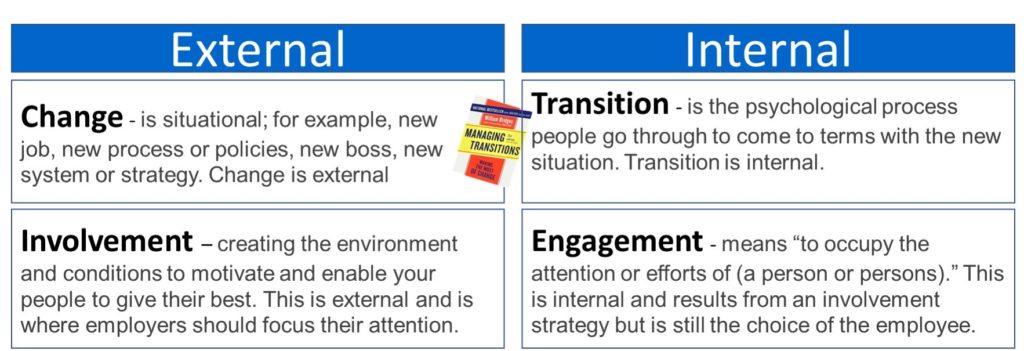Focus on Involvement NOT Engagement
Engagement is the wrong focus for achieving the results promised by engagement surveys and engagement plans. You cannot make engagement happen anymore that you can make transition happen.
We differentiate between change and transition, following William Bridges definitions. Change is the external situation that is happening, transition is the internal process of assimilating or resisting the change. Even changes that we choose require internal transition. When people go through a “change process” that refers to an internal transition response to the external change.

Engagement is an internal process. Engagement is a choice. No external force can make the internal process of engagement happen any more than you can force someone to make an internal transition in response to change. We work on involving employees as a strategy to help them make the choice to become engaged. It’s a subtle but very important difference.
Considerations for developing an involvement strategy:
- Start with People – who are you involving and what do they need to be, know or do? We just facilitated fifty leaders through an involvement process where they wrestled with the culture behaviors of their newly integrated organization. The focus was on them and the change process they were going through. We limited the data dumping and gave the group a chance to discuss the collective behaviors needed to be successful. Then each leader made a public presentation to their peers of a specific behavior they were committed to doing to support the new culture. At the end of the session there was a powerful sense of purpose and future direction that they created through their involvement in the process.
- Make Space – too often leaders create the opposite impact that they desire. The more you do for people, the less they do for themselves. We repeatedly hear that leaders want their people to take responsibility for their development, they want their team to take calculated risks or they need to “see it and solve it.” At the same time, the leader is giving directions or making detailed correction, and stifling initiative. People can’t get involved if there is no room for them to bring their brilliance. Make space and invite people to be involved.
- Ownership – If you ask employees questions, then why not let them own what they say? Asking without action is the biggest letdown of the typical employee survey. A survey is the beginning of a conversation. The next step is to involve employees in a discussion about the meaning of the results. Data without discussion creates silly solutions to potentially non-existent issues.
Get your people engaged by involving them. Focus on the people and make space for them to bring the best of themselves to the situation. Then accelerate involvement by giving them ownership.
